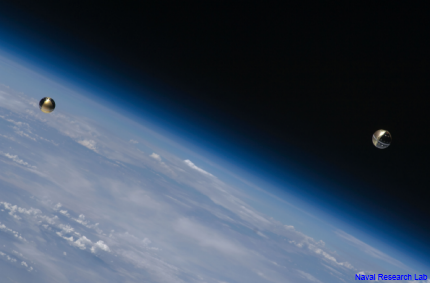Navy's new 'beach ball' satellite takes a spin from the ISS
The SpinSat's unique design could pave the way for better control of small satellites.

NRL illustration of SpinSats in orbit.
Astronauts aboard the International Space Station have launched a spherical, beach ball-sized satellite whose performance could help the military in its quest for smaller, less expensive satellites that can be used to extend communications or support specific missions.
Developed by the Naval Research Lab, the SpinSat’s primary mission is to test a new thruster technology that could be applied to altitude control for small satellites the Navy is developing, such as cube, pico and nano satellites.
Astronauts Barry "Butch" Wilmore and Terry Virts deployed the SpinSat on Nov. 28, NRL said in a Jan. 12 statement. By early December, NRL’s Andy Nicholas, SpinSat’s primary investigator, and others at the lab had made contact and started collecting data on the satellite's spin rate.
SpinSat has 12 sets of six tiny thrusters that fire when they receive electric current, and can be fired in pairs to spin the satellite. And it’s energy-efficient, NRL said—using its primary batteries and 4.8 grams of “green” fuel, the thruster tests are expected to last six months.
Meanwhile, SpinSat also will be used to test the Space Surveillance Network, the collection of ground-based radars and optical sensors around the world that tracks objects in space, partly with an eye toward preventing collisions.
The satellite’s aluminum shell is coated with gold iridite and black anodized in four alternating sections (like a beach ball), and contains retroreflectors each made of three flat mirrors. NASA’s International Laser Ranging Service will fire lasers at SpinSat, and the mirrors will reflect back to the ILRS, allowing scientists to determine its exact position and spin rate.
And the satellite’s unique, spherical shell will allow researchers to study the drag on it more precisely than with other satellites, which could lead to better models of the Earth’s atmospheric density. Better atmospheric models could in turn lead to more accurate orbital plans for future space craft.
Going small is one of the approaches the military is exploring in order to reduce the costs of satellite operations. The Navy’s Program Executive Office Space Systems, along with the Space and Naval Warfare Systems Center Pacific, is developing an inexpensive nano satellite that would hop a ride into space aboard a larger satellite, then be deployed. That nano sat, called the Integrated Communications Extension Capability, or ICE-Cap, could provide a communications relay that would extend halfway around the world.
In addition to hitching rides with larger satellites, the military also is exploring other options, such as reusable launch vehicles and sharing launches with commercial satellites. SpinSat used another alternative, being included in a SpaceX Falcon 9 resupply mission to the ISS.



